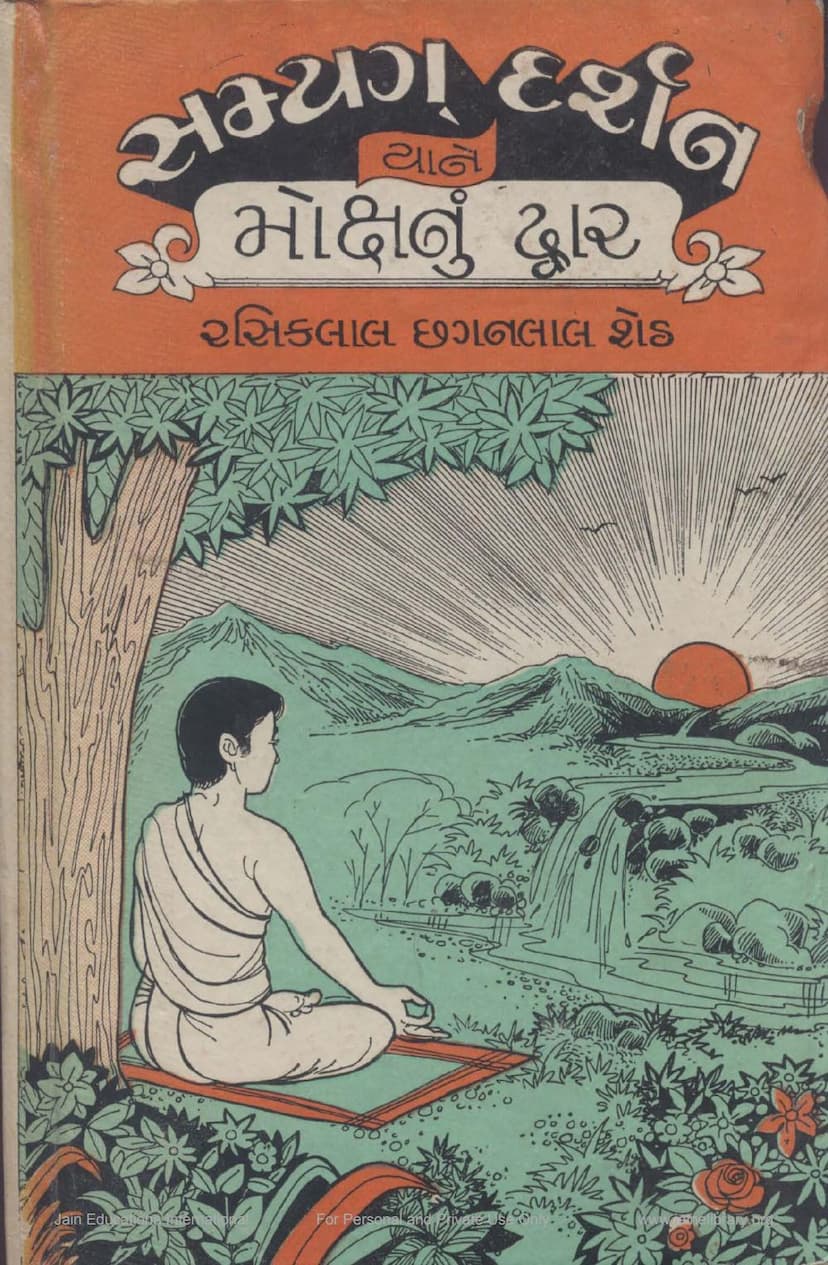Samyag Darshan Yane Mokshnu Dwar
Added to library: September 2, 2025

Summary
This document is a summary of the Jain text titled "Samyag Darshan yani Mokshnu Dwar" (Right Faith, the Door to Liberation) by Rasiklal C. Sheth. The book, published by Virvani Prakashan Kendra, is part of the Matushri Dahibai Granthamala series.
The text deeply expounds on the concept of Samyag Darshan (Right Faith) in Jainism, highlighting its crucial role as the gateway to Moksha (Liberation).
Here's a breakdown of the key themes and content:
-
Introduction and Dedication: The book begins with a dedication to Param Pujya Kusum Bai Mahasatiji, acknowledging her virtues and influence. It then introduces the central theme: the importance of Samyag Darshan and how to recognize it through external signs and internal qualities.
-
Characteristics of Samyag Darshan: The text elaborates on the characteristics that define a person with Right Faith (Samyak Darshan). These are categorized into:
- Three Lingas (Signs):
- Shushrusha of Sutra Siddhanta: The inclination and dedication towards studying Jain scriptures and principles.
- Param Anurag in Dharma Sadhana: Deep love and commitment to spiritual practices.
- Bhavpurvak Vaiyavachya of Jineshwar and Gurvadi: Devotion and service towards the Tirthankaras (Jineshwar) and spiritual preceptors (Gurvadi).
- Five Lakshanas (Qualities):
- Sham (Calmness/Equanimity): Maintaining equanimity in all circumstances.
- Samveg (Spiritual Zeal): Enthusiasm and passion for spiritual pursuits.
- Nirved (Dispassion/Detachment): Detachment from worldly pleasures and possessions.
- Anukampa (Compassion/Kindness): Empathy and compassion towards all living beings.
- Aastha (Faith/Conviction): Unwavering faith in the Jain principles, Tirthankaras, and scriptures.
- Three Lingas (Signs):
-
Illustrative Examples: The book uses the life of Param Pujya Kusum Bai Mahasatiji as a prime example, illustrating how she embodied these qualities and signs throughout her life. Her dedication to studying scriptures, her unwavering devotion to spiritual practice, her meticulous service to her preceptors, and her embodiment of the five qualities are highlighted through specific anecdotes, such as her practice of waking up early for chanting, observing Ekasana (eating only one meal a day), and maintaining silence during the fasting period, which remarkably improved her health.
-
Mithyatva (False Belief/Wrong Faith): The text also discusses the opposite of Samyag Darshan, which is Mithyatva. It explains its definition (beliefs contrary to Jain scriptures) and its various types based on the duration of its existence (anadi-anant, anadi-sant, sadi-sant) and its manifestations (25 types are mentioned, categorized as Abhigrahik, Anabhigrahik, Abhiniveshik, Sanshayik, Anagama, Laukik, Keshar, Ku-pravachnik, etc.). The detrimental impact of Mithyatva on spiritual progress is emphasized.
-
Path to Samyag Darshan: The book details the gradual path to attaining Samyag Darshan, including the concept of 'Upurvakaran' and 'Anivartikaran' (stages of spiritual progress). It explains how specific karmas (like Mohaniya Karma) act as obstacles and how their removal leads to the purification of the soul and the manifestation of Samyag Darshan.
-
Types of Samyag Darshan: The text classifies Samyag Darshan into four main types: Upasham (subsided), Kshaya-upasham (partially destroyed-partially subsided), Vedak (experiencing), and Kshāyik (completely destroyed). It also briefly touches upon 'Sasvadan' (tasting) Samyag Darshan.
-
Significance of Samyag Darshan: The book repeatedly emphasizes that Samyag Darshan is the foundation for all spiritual progress and the only path to Moksha. Without it, even rigorous practices like severe austerities may not yield the desired spiritual outcome.
-
The Role of Faith: The text underscores the paramount importance of 'Shraddha' (Faith) as the core of Samyag Darshan. It is presented as the key to understanding the true nature of the soul and the universe, and the ultimate means to attain spiritual liberation.
-
Six Stages of the Soul: The book discusses the six stages of the soul's existence and the path to achieving liberation, highlighting the importance of understanding the soul's inherent nature.
-
The "Sixty-Seven Boles" (Points) of Samyag Darshan: A significant portion of the text is dedicated to detailing the 67 points that constitute perfect Samyag Darshan. These include the four types of faith, three signs, ten types of humility (Vinay), three types of purity, five faults to avoid, five virtues to cultivate, five characteristics, eight types of 'Prabhavana' (spreading the glory of Jainism), six types of protection (Jayanā), six types of allowances (Agār), six contemplative practices (Bhavana), and six foundational truths (Sthanak).
-
Concluding Message: The book concludes by urging readers to cultivate these virtues, especially Samyag Darshan, and follow the path laid out by the Tirthankaras to achieve ultimate liberation. It serves as a guide to understanding and practicing the fundamental principles of Jainism for spiritual upliftment.